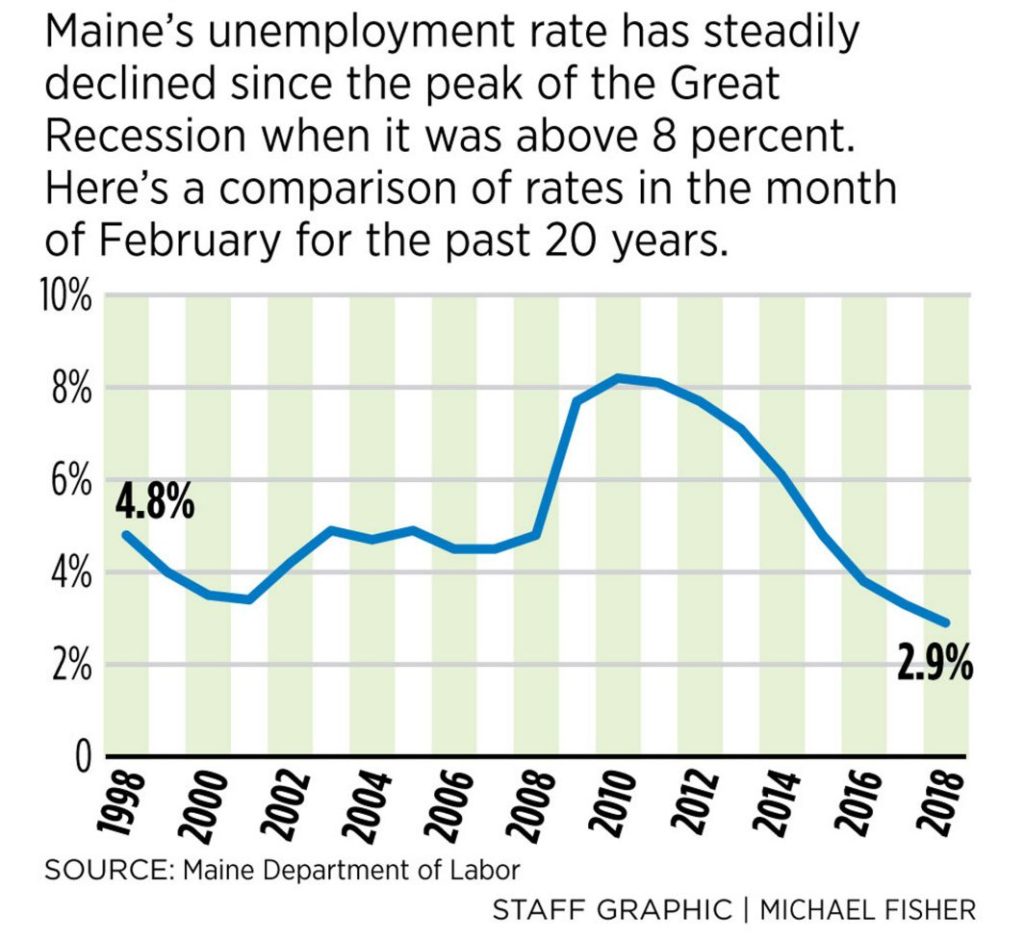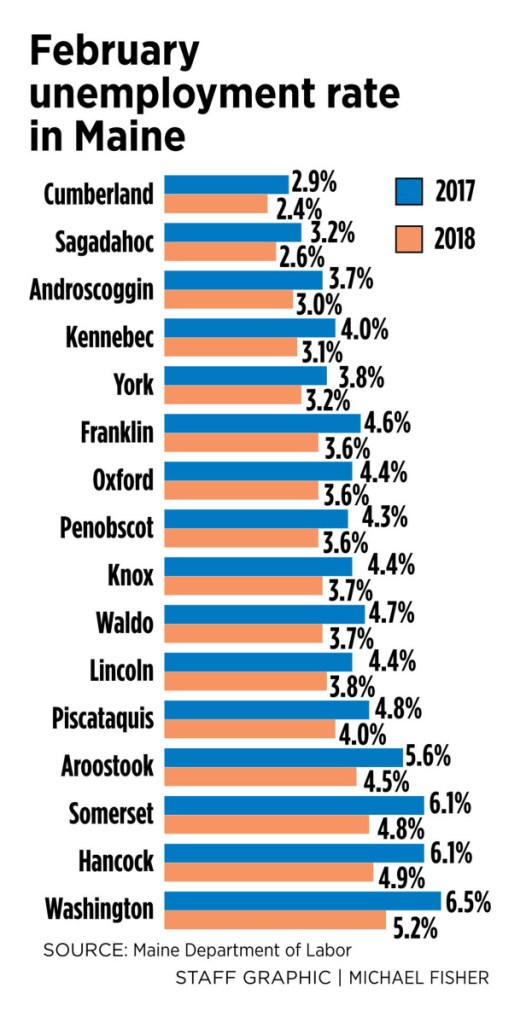For the first time in 40 years, Maine’s unemployment rate has dropped below 3 percent – a sign of an improving economy but also a reminder that the aging state has challenges in finding qualified people to fill vacancies.
February’s preliminary rate of 2.9 percent was a slight decrease from the previous month and the lowest it has been since 1976, according to the Maine Department of Labor.
The number of unemployed Mainers dropped by 3,000 from the January level to 20,000 in February.
Gov. Paul LePage trumpeted the low rate as proof that his administration has been successful on economic matters, although the rate does not capture people who have, for whatever reason, stopped looking for work.
“When I took office I promised the Maine people that their prosperity is my priority,” he said in a statement. “Our administration continues to put the right policies in place that put people back to work and encourage our businesses to grow.”
LePage made special note of the growth in private sector jobs and said workers are earning more as well – about 1.6 percent more on average compared to last year.
Business experts and economists said the low unemployment rate is certainly welcome, but it creates challenges, too.
“There are a lot of people who feel a rate this low means the job market is too tight,” said Ed McKersie, who heads the Portland-based staffing firm ProSearch. “If employers can’t find workers, it can slow their growth.”
Quincy Hentzel, CEO of the Portland Regional Chamber of Commerce, said many members are finding it hard to fill slots. The tourism industry, in particular, has been hit hard.
“A compounding factor is that we’re one of the oldest states, so we have this huge demographic cliff looming where there’s going to be an incredible shortage of workers,” Hentzel said.
RECRUITMENT CHALLENGES
A group of waterfront business owners gathered Friday at the Maine Boatbuilders Show in Portland to talk about how to attract more young people to consider careers in the commercial and marine economy, saying they are facing huge recruitment challenges. Baby boomers are retiring and there is no one interested, much less qualified, to fill boatbuilding, aquaculture and marina jobs integral to Maine’s coastal economy, said Erno Bonebakker, vice president of The Waterfront Alliance.
The industry must expose Generation Z to the waterfront and train them, said instructor Mike Smith of the Portland Arts and Technology High School.
“These are kids that were raised with cellphones and tablets,” Smith said. “They didn’t grow up like we did building go-karts and minibikes, making a tree fort, pounding nails. They don’t know any better. I have kids that come into the program that can’t tell you the difference between slip-lock pliers and Vise-grips. They don’t know what a No. 2 screwdriver is. You have to start from square one.”
Many of the business owners and waterfront industry representatives at the boatbuilders’ show agreed. Many lobster dealers are willing to train almost anyone as long as they are willing to work hard and show a willingness to learn, said Annie Tselikis, the executive director of the Maine Lobster Dealers Association. Phineas Sprague, the owner of Portland Yacht Service, said waterfront businesses need to work with educators and go find young people where they are to recruit them.
“They want to be connected to the water,” Sprague said. “We just have to show them the way. We’ve lost a generation, maybe even two, and when you do that, the way is forgotten. We have to remind them.”
‘A TWO-EDGE SWORD’
Glenn Mills, chief economist with the Maine Department of Labor, said the record low rate is great news for people looking for a job.
“It’s a two-edge sword, but this is an environment we’ve known would be coming,” he said “With so many more people heading toward retirement than young people coming into the workforce, it’s likely to create an even tighter market going forward.”
Mills said the challenge with the tourism industry was expected. There have been fewer young people and as the economy has improved, more tourists are coming in, so businesses are busier.
LePage acknowledged Maine’s demographic challenges.
“As the oldest state, we must attract younger people so that businesses are not held back when older workers move on to their well-earned retirement,” he said.
Other New England states are seeing low unemployment rates, too. New Hampshire, at 2.6 percent, and Vermont, at 2.8 percent, came in lower than Maine last month, and Massachusetts wasn’t far off at 3.5 percent. All four were well below the national average of 4.1 percent, which has been steady for the last five months.
Cumberland County had the lowest rate of any Maine county, at 2.4 percent. Washington County was the highest at 5.2 percent, with nearby Hancock County close behind at 4.9 percent.
RATE SHOULD REMAIN LOW
Maine’s unemployment rate reached a high of 8.3 percent during the Great Recession in the summer of 2009, but has been dropping steadily since, roughly at the same rate as the rest of the country. The rate in Maine dropped below 6 percent by early 2014 and below 5 percent a year later.
Mills predicted that – absent any financial shock – the rate should remain low for years to come.
McKersie said in his line of work, the tight job market has been good for temporary workers. A lot of them, he said, are being hired on a permanent basis.
He said the best thing employers can do is move quickly on their hires.
“Don’t be sloppy,” he said. “But if you don’t move fast, you’ll risk losing someone,” he said.
He also said employers would do well to be flexible. If a candidate doesn’t have all the skills or qualifications, employers should ask: Are they trainable? And do they fit in?
And he expects employers to continue reaching out beyond the state’s borders.
“Maine has a lot to sell from a quality-of-life standpoint,” he said.
Hentzel said the tight market is making employers more competitive. That means some are offering incentives or getting more creative in their hiring.
Diana Roberge, a recruiter for Hannaford, one of Maine’s largest private employers, said the company has a wide range of positions open, from part-time jobs in retail to management jobs at its corporate headquarters in Scarborough.
“We just have to get more creative with how we recruit,” she said, adding that face-to-face networking has become a valuable tool.
Hentzel said one thing Portland can do – and Lewiston, too – to prepare for a deluge of job openings created by soon-to-be retirees is to work closely with the growing immigrant population
“That is certainly a part of the solution to the overall workforce challenges we have,” she said.
Staff Writer Penelope Overton contributed to this report.
Eric Russell can be contacted at 791-6344 or at:
Twitter: PPHEricRussell
Send questions/comments to the editors.





Success. Please wait for the page to reload. If the page does not reload within 5 seconds, please refresh the page.
Enter your email and password to access comments.
Hi, to comment on stories you must . This profile is in addition to your subscription and website login.
Already have a commenting profile? .
Invalid username/password.
Please check your email to confirm and complete your registration.
Only subscribers are eligible to post comments. Please subscribe or login first for digital access. Here’s why.
Use the form below to reset your password. When you've submitted your account email, we will send an email with a reset code.